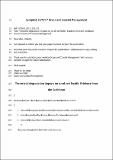Files in this item
Terrestrial degradation impacts on coral reef health : evidence from the Caribbean
Item metadata
| dc.contributor.author | Roberts, Michaela Holly | |
| dc.contributor.author | Hanley, Nick | |
| dc.contributor.author | Williams, Sam | |
| dc.contributor.author | Cresswell, Will | |
| dc.date.accessioned | 2018-09-25T23:46:45Z | |
| dc.date.available | 2018-09-25T23:46:45Z | |
| dc.date.issued | 2017-11-15 | |
| dc.identifier | 251061650 | |
| dc.identifier | 43e55673-884b-4ee6-9df7-3a33eac95de9 | |
| dc.identifier | 85029784244 | |
| dc.identifier | 000414878500006 | |
| dc.identifier.citation | Roberts , M H , Hanley , N , Williams , S & Cresswell , W 2017 , ' Terrestrial degradation impacts on coral reef health : evidence from the Caribbean ' , Ocean and Coastal Management , vol. 149 , pp. 52-68 . https://doi.org/10.1016/j.ocecoaman.2017.09.005 | en |
| dc.identifier.issn | 0964-5691 | |
| dc.identifier.other | ORCID: /0000-0002-4684-7624/work/60426942 | |
| dc.identifier.uri | https://hdl.handle.net/10023/16077 | |
| dc.description | Funding: University of St Andrews, School of Geography and Geosciences; Van Eeden Foundation [Project number: 201505]; and the Sophie Danforth Conservation Biology Fund. | en |
| dc.description.abstract | Coral reefs are in decline worldwide. While coral reef managers are limited in their ability to tackle global challenges, such as ocean warming, managing local threats can increase the resilience of coral reefs to these global threats. One such local threat is high sediment inputs to coastal waters due to terrestrial over-grazing. Increases in terrestrial sediment input into coral reefs are associated with increased coral mortality, reduced growth rates, and changes in species composition, as well as alterations to fish communities. We used general linear models to investigate the link between vegetation ground cover and tree biomass index, within a dry-forest ecosystem, to coral cover, fish communities and visibility in the case study site of Bonaire, Caribbean Netherlands. We found a positive relationship between ground cover and coral cover below 10m depth, and a negative relationship between tree biomass index and coral cover below 10m. Greater ground cover is associated to sediment anchored through root systems, and higher surface complexity, slowing water flow, which would otherwise transport sediment. The negative relationship between tree biomass index and coral cover is unexpected, and may be a result of the deep roots associated with dry-forest trees, due to limited availability of water, which therefore do not anchor surface sediment, or contribute to surface complexity. Our analysis provides evidence that coral reef managers could improve reef health through engaging in terrestrial ecosystem protection, for example by taking steps to reduce grazing pressures, or in restoring degraded forest ecosystems. | |
| dc.format.extent | 1155633 | |
| dc.language.iso | eng | |
| dc.relation.ispartof | Ocean and Coastal Management | en |
| dc.subject | Sediment | en |
| dc.subject | Environmental conservation | en |
| dc.subject | Dry forest | en |
| dc.subject | Island ecosystems | en |
| dc.subject | Bonaire | en |
| dc.subject | GC Oceanography | en |
| dc.subject | QH301 Biology | en |
| dc.subject | NDAS | en |
| dc.subject | SDG 15 - Life on Land | en |
| dc.subject.lcc | GC | en |
| dc.subject.lcc | QH301 | en |
| dc.title | Terrestrial degradation impacts on coral reef health : evidence from the Caribbean | en |
| dc.type | Journal article | en |
| dc.contributor.institution | University of St Andrews. School of Geography & Sustainable Development | en |
| dc.contributor.institution | University of St Andrews. School of Biology | en |
| dc.contributor.institution | University of St Andrews. Scottish Oceans Institute | en |
| dc.contributor.institution | University of St Andrews. Institute of Behavioural and Neural Sciences | en |
| dc.contributor.institution | University of St Andrews. St Andrews Sustainability Institute | en |
| dc.contributor.institution | University of St Andrews. Centre for Biological Diversity | en |
| dc.identifier.doi | https://doi.org/10.1016/j.ocecoaman.2017.09.005 | |
| dc.description.status | Peer reviewed | en |
| dc.date.embargoedUntil | 2018-09-26 |
This item appears in the following Collection(s)
Items in the St Andrews Research Repository are protected by copyright, with all rights reserved, unless otherwise indicated.

